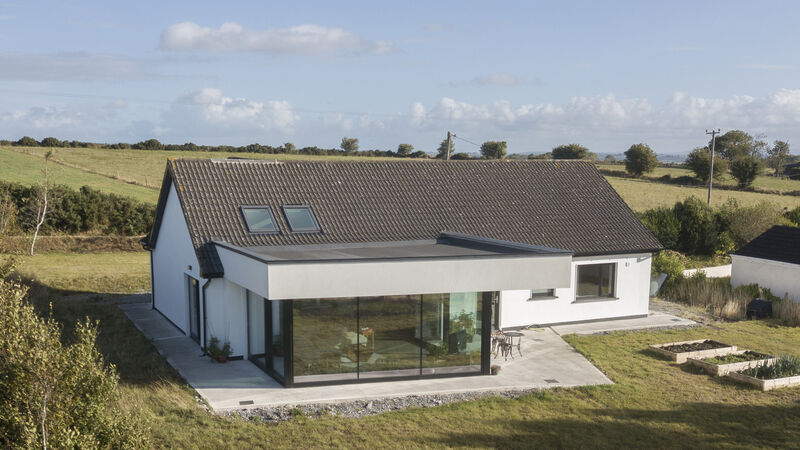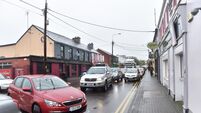Back to the future: How Ireland's unassuming 1980s bungalow is stealthily making a comeback

Architect Loïc said the house needed to make the most of the site's advantages. Pictures: Dan Linehan
TEASED perms, inflated shoulders, spandex leggings: the tastemakers of the 1980s had much to answer for but maybe so did the planners?
Wasn’t it under their watch that the country went stone mad for building bungalows?
They went up at such a rate that Bungalow Bliss (the book that inspired the craze) became, in hindsight, bungalow blight, and the modest single-storey home became the most derided house-type ever to blot the Irish landscape.


Like everything that goes out of vogue though, it eventually returns to the spotlight and today the unassuming 1980s bungalow is stealthily making a comeback. In an expensive housing market, these unpretentious homes are often more competitively priced, no doubt helped by the lack of fanfare around their architecture.
The home showcased on these pages had many of the features we associate with a typical 1980s bungalow when its owners bought it during the first Covid lockdown in 2020, after prolonged house hunting for a site with privacy. They had been living in a two-bed apartment, and before that, in a two-bed home, in a housing estate.
“It was your classic 1980s bungalow, with a hallway the length of the house,” the woman of the house says.


And even though it was on a lovely, elevated site in Currahaly, Farran, Farnanes, its design failed to capitalize on the beauty on its doorstep.
“We wanted it opened up so that we could see the countryside and we wanted to make it bigger and have it work better,” the owners say.
“And we also wanted to focus on insulation. That was one of our main priorities.”
They set about looking for an architect that could help implement their vision. Some that they spoke to pitched ideas they felt didn’t really tally with their dream. On the recommendation of a friend, they met with Cork-based French architect Loïc Dehaye, of Loïc Dehaye Architects Ltd.
“He got what we wanted to do with it,” the owners say.
Loïc says that from an architectural perspective, the site had great qualities, but the house was not making the most of them.
“It was well exposed and it was south-facing.
“But the house was in its original state, a four-bed, with small enough rooms. It was not a very well worked-out layout and it was not open to the south to take advantage of those fantastic views,” Loïc says.
He set about changing that. Contrary to your typical home extension, the planning brief was to downsize the number of bedrooms, from four to three. The brief was also to create a large, open-plan living space, and in the process, to improve the relationship between the house and its surroundings.


The owners were anxious for work to get underway and because the extension was to the rear and under 40 sq m, there was no requirement to obtain planning permission.
“Loïc came up with a plan that maximised every room and made sure they were all very well proportioned. He put on a lovely, light-filled extension and he did it within the budget we could afford. He listened to what we wanted,” the owners say.
While they don’t wish to divulge the cost of the project (the cost of building materials rose dramatically during construction due to supply problems, not helped by a six-day blockage of the Suez Canal after the grounding of a container ship), they are happy to reveal what the original 123 sq m (1,324 sq ft) house cost them: €390,000. It came with four bedrooms, two bathrooms, a sitting room to the front and a back kitchen and it stood on about one-third of an acre.
The re-modelling plan did not require a change to the front elevation and the sitting room was left as is, as it was “a good size”, Loïc says.
Although the rest of the house was re-modelled, Loïc says it was “an easy structure to work with” as they were keeping the external walls and the roof.
As part of the insulation process, cavity walls were pumped and then lined. The roof was not touched but the ceiling inside was removed.


“We kept the structure but we needed to remove the ceiling in order to fit an air-tight membrane. It was then replastered. We insulated the attic space too.
“We used cellulose insulation, made by Ecocel (based at the Marina Commercial Park on Centre Park Road, Cork City). It’s made from recycled newspaper, after it’s been read of course,” he laughs.
All of the internal partition walls were removed, apart from the front room, where they built a concrete block partition. Underfloor heating was installed throughout too.
There was discussion around what to do with the windows and on advice from Loïc, the couple went with triple-glazing for the glass extension and double-glazing elsewhere to the rear, as it is south-facing.
“We had thought about triple-glazing the whole lot, but Loïc said that was not the right thing to do, and he was right,” the man of the house says.
As a result of thorough and considered insulation work, they have a constant even temperature in the house, regardless of external factors.
“Even at the height of the heatwave this year, it was lovely,” the owners say.
“You might think that with all that glass and because it’s south-facing, we would have been cooking, but that was not the case.
“The triple-glazing was very effective from that perspective, and we also had a nice breeze going through the extension because of sliding doors on either side,” the owners add.
In fact there are three sliding doors in total in the extension, one on either side of the glass box (leading to patio areas) and one beside the kitchen area.
Ventilation is not only via these doors, but also through a light well. There are two velux roof lights, remotely controlled, (which can also be activated by smartphone) and because they have sensors fitted, they close automatically if it rains.
“It was Loïc who suggested it and it was a very smart thing to do because if you’ve left the window open and you are not at home, it will close if it rains,” the man of the house says.
The veluxes also contribute to ventilation.
“Even with a lot of glass, the extension didn’t overheat during the summer and the owners told me they were happy that they were able to manage during the heatwave,” says Loïc, who is a certified Passive House Designer from the Passivhaus Institut Dr Wolfgang Feist, Darmstadt, Germany.
With all that glazing, the extension is wonderfully light-filled. It’s also a fabulous place to sit and enjoy rolling countryside views, out over the Bride Valley and East Muskerry, from a comfortable seating area. Loïc designed the open plan extension so that the seating is to the front, close to the floor-to-ceiling windows (by 2020-Glazing) and the kitchen is towards the back of the room. The huge couch is from 1922 Furniture near Navan, in Co Cavan.


The kitchen, by Classic Kitchens, in Carriagline, has some striking copper features, including a copper sink and copper mixer tap in the island. Kitchen units have a warm earthy tone and work well with the copper. There’s a lovely timber breakfast bar attached to one side of the island, with plenty of space also for a separate dining table.
A grandfather clock, (a family heirloom) was restored and painted ‘Scooter Red’ by the man of the house and adds a striking pop of colour to the pale walls.
Outside is lovely for a morning coffee, the woman of the house says, thanks to Loïc’s creativity and attention to detail.
“He really got the importance of small details, like including an overhang around the extension,” she adds.
The overhang is longer on the eastern elevation, about 2m beyond the glazed wall, creating a corner sheltered from the elements. There’s an overhang on the southern and western elevations too, not as large, but designed for sun protection.
The owner says the overhang provides a great canopy. She also likes the fact that it gives an extra edge to the extension, so that “it’s not just a glass box”.
“I hate everything being a complete box or square. Loïc got that right, it keeps it interesting and it’s small details like that that make the difference,” the owner says.
While the open plan extension was the main part of the project, the main bedroom was remodelled too. They took one bedroom out to increase the size of their bedroom and they installed an ensuite. It’s a double-aspect room, with the bigger window making the most of the south-facing view.
Other work involved putting in a utility room and rejigging the layout to get rid of the long internal corridor. A stunning polished concrete floor was laid in the entrance porch and the open-plan area.
The couple moved in last November. The project took eight to 10 months to complete, with some delays due to Covid, and some extra costs due to the rising price of materials. While a build price had been agreed in advance, the couple absorbed some of the additional cost in recognition of the hit their builder would otherwise take. Chq Builders worked on the project and the couple was very pleased with their performance.
The house is not totally finished yet – the owners still have some floors to lay, but they are not in a rush, and are enjoying what’s been achieved so far. They’re delighted that the focus on insulation has improved their home’s energy efficiency from a D2 to an A-rating.
“When all the work was done, an air-tightness test was done and on the day, the readings were even lower than expected. The energy efficiency is even better than anticipated,” the man of the house says. The decision to remove a chimney and not to install an open fire (Loïc’s advice that they wouldn’t need one was correct) also helped in achieving that rating.
With happy clients, Loïc, whose own home featured in the RTÉ series Home of the Year, and who specialises in one-off house design and passive house design, says their new-look home is “a great example of what can be done with a typical ‘80s bungalow”.
Although the extension added just 26 sq m, the house has been transformed. Loïc says the typical ‘80s bungalow has “great potential” but the real bonus here was the location and the exceptional views.
“The view is so spectacular and ever-changing, as the site is elevated. And the house makes the most of those views now and is much better connected to the landscape.
“My clients wanted a modern, comfortable home with a better relationship to the site it is on, so that’s what we have done. And with its a-rating, it’s been future-proofed too.”










